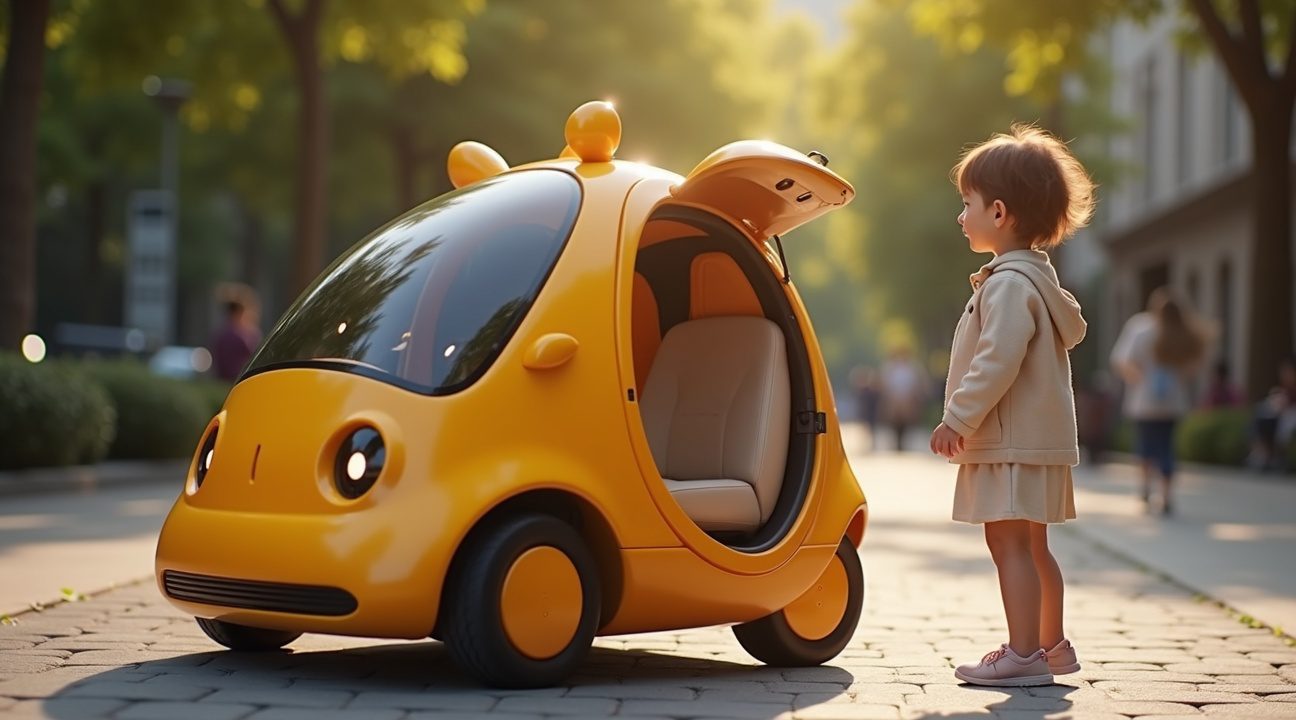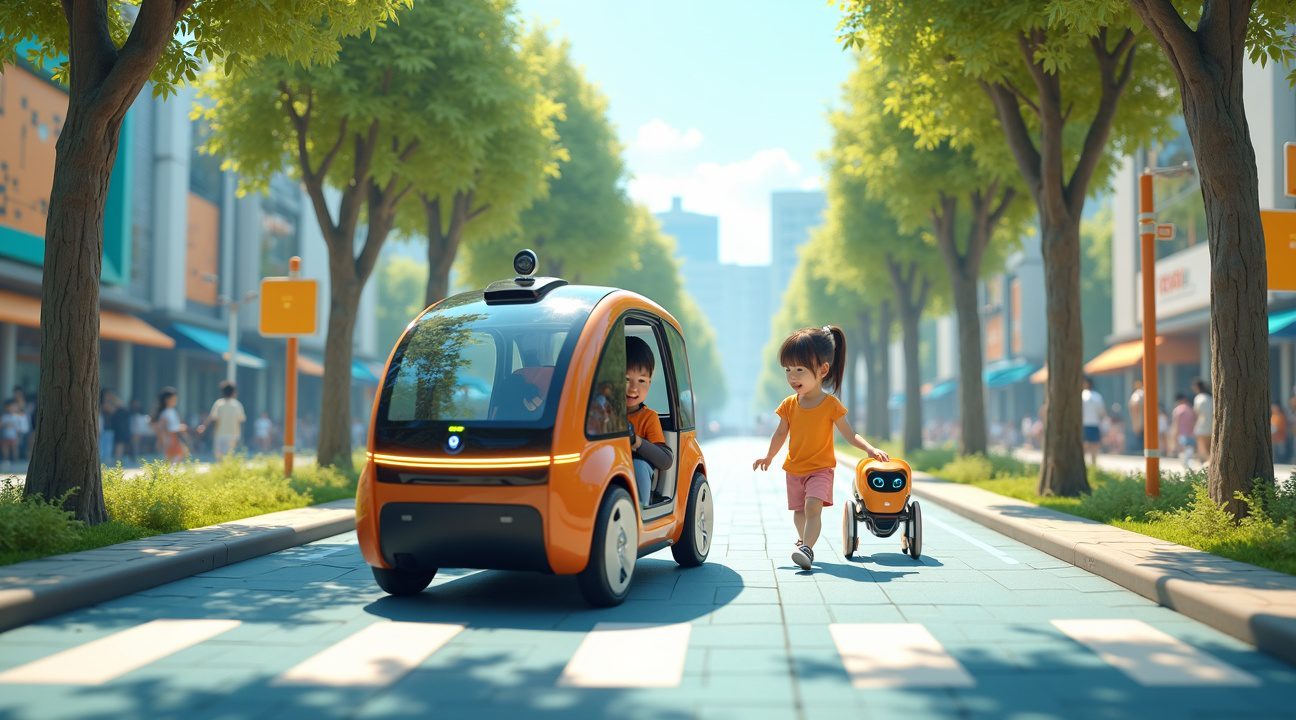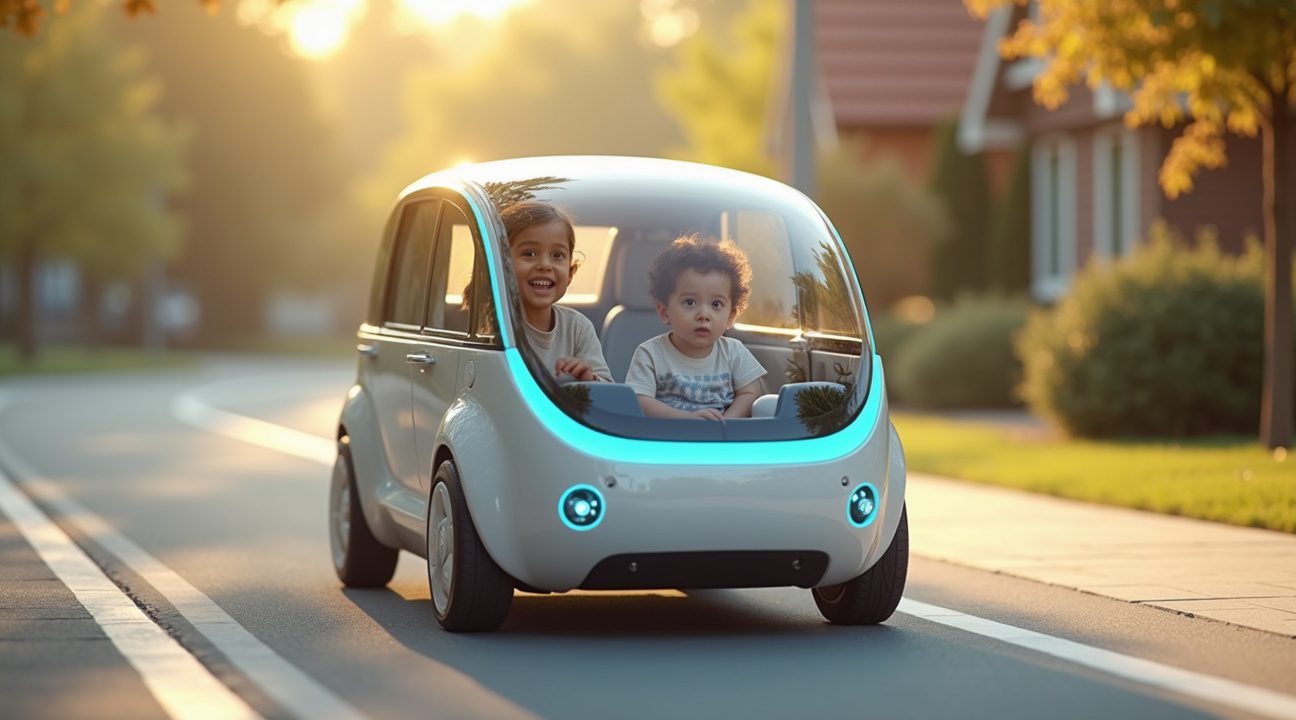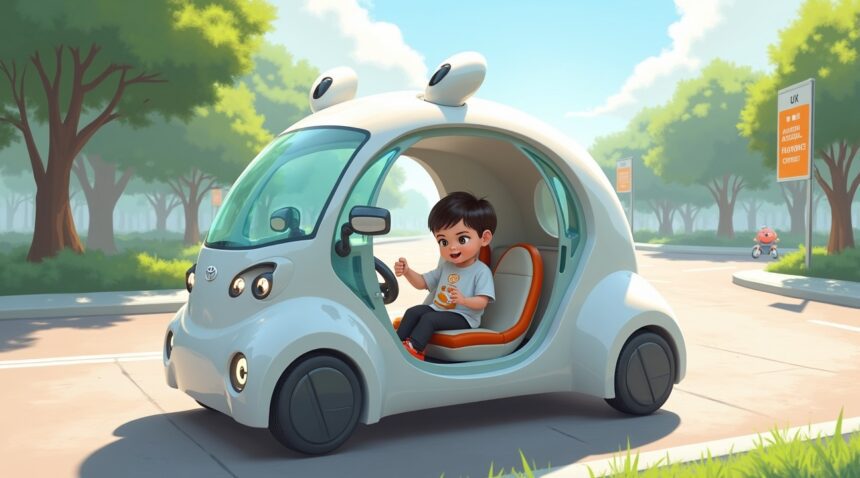Toyota has unveiled the Kids Mobi, an innovative, fully autonomous electric vehicle tailored for children up to 130 cm tall, featuring a whimsical bubble-shaped design and a smart AI companion system.
Key Takeaways
- Child-Friendly Design: The Kids Mobi boasts a bubble-shaped, pod-like structure complete with animated LED “eyes” and safety sensors hidden within animal ear-like shapes, helping reduce anxiety linked to autonomous travel.
- Interactive AI Assistant: “UX Friend,” an AI-powered companion, offers conversational interaction, age-appropriate entertainment, and educational content customized to each child for an engaging in-vehicle experience.
- Completely Autonomous Operation: The vehicle requires no adult supervision and is intended for low-risk zones such as sidewalks and bike lanes, avoiding high-traffic areas to ensure child safety.
- Advanced Safety Features: Designed with soft interior materials, a lifting canopy for easy boarding, fully enclosed wheels, and rounded edges, the vehicle aims to minimize injury risks from any potential impacts.
- Part of Toyota’s AI x Robotics Initiative: The Kids Mobi is integrated into Toyota’s broader AI x Robotics Data Center vision, reinforcing the automaker’s leadership in age-specific, futuristic mobility solutions for children.
A Bubble-Shaped Design Built for Safety and Comfort
Toyota’s Kids Mobi stands out with its distinctive bubble-shaped, pod-like body that transforms the concept of children’s transportation. The smooth, rounded exterior eliminates sharp edges and protrusions, creating a safer environment for young passengers while maintaining an approachable aesthetic that appeals to children.
Character-Inspired Features That Build Trust
The vehicle’s friendly design draws inspiration from animated film characters, making it instantly recognizable and comforting to children. Animated LED ‘eyes’ serve as more than decorative elements—they display various expressions that create an emotional connection with young passengers. This feature helps establish trust and provides a reassuring presence for children traveling alone.
Safety sensors and navigation equipment are cleverly disguised as animal-like ears positioned on the roof. This thoughtful integration makes essential safety technology appear less intimidating and more approachable to children. The design choice demonstrates Toyota’s understanding that advanced self-driving cars need to feel familiar and safe to young users.
Interior Comfort and Accessibility
Inside the Kids Mobi, a single-seat cabin creates a cozy, personal space designed specifically for children up to 130 cm tall. Soft materials line the interior, providing comfort and reassurance during rides. The thoughtful material selection prioritizes both safety and emotional well-being.
Access to the vehicle couldn’t be simpler. A lifting canopy opens upward, allowing children to enter and exit safely without struggling with traditional doors. This design eliminates pinching hazards and ensures young passengers can access their transportation independently.
Toyota’s commitment to safety extends beyond visual appeal. Every design element emphasizes child protection, with the company aiming to match or exceed traditional school bus safety standards through autonomous technologies. The fully enclosed wheels prevent curious hands from getting caught, while the pod-like structure provides comprehensive protection from external elements.
The Kids Mobi represents a significant step forward in child-focused transportation design. Unlike futuristic concepts we’ve seen with flying car makes its debut announcements, this vehicle focuses on practical, ground-based solutions for everyday transportation needs. The bubble design creates a secure environment where children feel protected while maintaining the independence that comes with personal transportation.
Toyota’s engineers have carefully considered every aspect of the design process. The rounded exterior isn’t just aesthetically pleasing—it’s functionally superior for child safety. The absence of sharp corners reduces injury risk during any potential impact, while the enclosed wheel design prevents accidents during boarding and disembarking.
The emotional design elements work together to create a vehicle that children actually want to use. The LED eyes respond to the child’s presence and can display different emotions based on the situation, whether greeting the passenger or indicating arrival at their destination. This interactive feature transforms what could be an intimidating autonomous vehicle into a friendly companion.
Construction materials prioritize both durability and safety. The soft interior lining provides comfort during the ride while protecting against minor bumps and movements. The lifting canopy mechanism includes safety features that prevent accidental closure during entry or exit, ensuring children have adequate time to settle in safely.
The Kids Mobi’s design philosophy extends beyond simple transportation. Toyota has created a vehicle that addresses the psychological needs of young passengers while maintaining the highest safety standards. The friendly appearance reduces anxiety about riding alone, while the advanced safety systems provide parents with peace of mind.
This innovative approach to children’s transportation design sets new standards for the industry. The combination of safety-focused engineering and child-friendly aesthetics creates a vehicle that serves both practical and emotional needs, making autonomous transportation accessible and appealing to its youngest users.

Advanced AI Technology Creates a Child-friendly Travel Experience
The Kids Mobi operates through a completely autonomous driving system that eliminates any need for adult supervision or remote control intervention. This self-driving technology represents a significant advancement in child-focused transportation, allowing young passengers to travel independently while maintaining complete safety protocols.
UX Friend AI Assistant Enhances the Journey
At the center of the vehicle’s experience sits an AI-powered companion called the UX Friend, specifically programmed to engage with children through interactive conversation and entertainment features. This digital assistant understands child psychology and adapts its responses to individual preferences, creating personalized interactions that keep young passengers calm and entertained throughout their journey.
The UX Friend actively works to reduce travel anxiety by maintaining constant communication with children, offering games, stories, and educational content tailored to their age and interests. This approach transforms what could be an intimidating experience into an enjoyable adventure, helping children build confidence in autonomous transportation.
Safe Simulated Control Features
While the Kids Mobi operates entirely through autonomous systems, it cleverly incorporates simulated control elements that give children a sense of agency without compromising safety. These interactive features allow young passengers to feel involved in their journey while the AI maintains complete operational control.
The vehicle includes child-friendly interfaces that respond to touch and voice commands, creating an educational experience that teaches basic transportation concepts. Children can “steer” through virtual scenarios or select destinations from pre-approved routes, all while the autonomous system handles actual navigation and safety decisions.
The Kids Mobi’s operational design focuses on pedestrian-friendly environments such as sidewalks, dedicated bike lanes, and other controlled spaces rather than busy city streets. This strategic approach distinguishes it from traditional electric vehicles and ensures maximum safety for its young passengers. The vehicle’s sensors and AI systems are calibrated specifically for these lower-speed environments, allowing for more precise navigation around pedestrians and obstacles.
This controlled environment approach enables the Kids Mobi to operate at speeds appropriate for children while maintaining the sophisticated technology that makes autonomous travel possible. The combination of advanced AI assistance and carefully designed operational parameters creates a transportation solution that’s both innovative and reassuring for parents concerned about their children’s independent mobility.
How Kids Mobi Fits Into Toyota’s Robotics Vision
Toyota didn’t develop the Kids Mobi in isolation. The automaker unveiled this autonomous electric vehicle alongside another fascinating concept called ‘Chibibo,’ a four-legged robot specifically designed to help children with deliveries. These complementary innovations reveal Toyota’s comprehensive strategy to weave robotics and artificial intelligence into support systems that enhance children’s daily experiences.
The Kids Mobi serves as the centerpiece of Toyota’s AI x Robotics Data Center initiative, a dedicated program focused on creating autonomous solutions specifically for young users. This strategic approach demonstrates how seriously Toyota takes the development of age-appropriate technology that can safely operate in environments where children are present.
Standing Apart from the Competition
While other manufacturers have explored child-focused mobility concepts, the Kids Mobi distinguishes itself through its autonomous capabilities and design for independent operation. Honda’s Shogo, for example, represents a small vehicle intended for hospital use, but it lacks the sophisticated self-driving features that make Toyota’s offering truly revolutionary. The Kids Mobi’s ability to operate without direct adult supervision sets a new standard for what’s possible in child mobility solutions.
Toyota’s vision extends beyond simple transportation. The integration of AI and robotics creates opportunities for these vehicles to learn from their young passengers’ behaviors and preferences, potentially adapting their responses to individual children over time. This personalized approach aligns with Toyota’s broader commitment to developing self-driving cars that understand and respond to human needs.
The strategic positioning of both the Kids Mobi and Chibibo within Toyota’s robotics portfolio suggests the company views children as early adopters who can help shape the future of autonomous technology. By designing these systems specifically for younger users, Toyota gains valuable insights into how humans interact with AI-powered machines in low-stakes environments.
This child-focused approach also addresses practical considerations that traditional automotive development often overlooks. Children interact with technology differently than adults, requiring interfaces that are intuitive, engaging, and safe even during unexpected situations. The lessons learned from these interactions could prove invaluable as Toyota continues developing autonomous systems for broader markets.
The timing of these announcements reflects Toyota’s understanding that tomorrow’s transportation landscape will be fundamentally different from today’s. Children who grow up with autonomous vehicles like the Kids Mobi will have different expectations and comfort levels with advanced transportation technology as they mature into adult consumers.
Toyota’s AI x Robotics Data Center initiative represents more than just product development – it’s a research platform that could influence the company’s entire approach to autonomous systems. The data collected from children’s interactions with the Kids Mobi and Chibibo will likely inform:
- Safety protocols
- User interface design
- Behavioral prediction algorithms
These insights may be applied across Toyota’s entire autonomous vehicle lineup.
The emphasis on unsupervised operation particularly sets Toyota’s vision apart from competitors who focus primarily on assisted or supervised autonomous features. This bold approach requires sophisticated safety systems and fail-safes that must account for the unpredictable nature of children’s behavior while maintaining the engaging experience that makes the technology appealing to young users.
By positioning these child-focused innovations as flagship components of their robotics vision, Toyota signals their belief that autonomous technology should enhance rather than replace human capabilities. The Kids Mobi doesn’t just transport children – it potentially teaches them about technology, independence, and responsible interaction with AI systems that will become increasingly prevalent throughout their lives.

What This Means for the Future of Child Transportation
The Kids Mobi prototype represents more than just a clever concept vehicle. I see this development as a potential catalyst for fundamental changes in how children experience transportation independence. Toyota’s unveiling at the 2025 Japan Mobility Show generated considerable attention, sparking conversations about whether autonomous vehicles could eventually allow children to travel safely without direct adult supervision.
The interactive exhibits at the mobility show allowed children to engage directly with the prototype, receiving branded keychains while exploring what could become their future mode of transport. These demonstrations highlight how manufacturers are already thinking beyond traditional family vehicles and considering specialized solutions for different age groups.
Shifting Paradigms in Child Mobility
The concept challenges established norms about supervision requirements for children’s transportation. Currently, parents must either accompany young passengers or rely on trusted adults to provide transport. A fully autonomous, AI-supervised system could potentially eliminate these constraints, creating unprecedented opportunities for childhood independence.
Several implications emerge from this technological possibility:
- Reduced dependence on parent schedules for school runs and extracurricular activities
- Enhanced access to educational and social opportunities for children in remote areas
- Potential cost savings for families currently paying for transportation services
- Greater flexibility in children’s daily routines and social interactions
Safety considerations will undoubtedly drive the development timeline for such vehicles. The AI supervision systems must demonstrate reliability far exceeding human drivers before gaining regulatory approval for unsupervised child transport. I expect extensive testing phases and gradual implementation, starting with controlled environments like school campuses or residential communities.
The technology also raises questions about childhood development and risk assessment skills. If children grow up in completely controlled transport environments, they might miss opportunities to develop street awareness and personal safety judgment that traditional transport methods provide.
Insurance and liability frameworks will require complete restructuring to accommodate autonomous child transport. Current policies assume adult supervision or responsibility, creating legal gaps that manufacturers and regulators must address before widespread adoption becomes feasible.
The Kids Mobi prototype connects to broader trends in autonomous vehicle development, where manufacturers are exploring specialized applications beyond standard passenger cars. Just as aviation companies are experimenting with personal flying vehicles, automotive manufacturers are recognizing that different demographics may require distinct transportation solutions.
This development signals a future where transportation becomes increasingly personalized and age-appropriate. Rather than adapting adult vehicles for children, manufacturers may design purpose-built solutions that address specific needs and safety requirements for different life stages.
The Road Ahead for Autonomous Child Mobility
Toyota’s Kids Mobi concept positions the company as a leader in developing child-focused autonomous transport solutions. This innovative vehicle represents more than a simple toy car—it embodies Toyota’s broader “Mobility for All” philosophy, which prioritizes equitable and safe access to transportation regardless of age.
The development of Kids Mobi reflects a significant shift in how manufacturers approach mobility technology. By focusing on children’s unique needs, Toyota demonstrates its commitment to creating transportation solutions that serve every demographic, including the youngest members of society. This approach aligns with the growing momentum behind self-driving cars and their potential to revolutionize transportation for all age groups.
Transforming Children’s Independence Through Technology
The Kids Mobi has the potential to transform how children experience independence and mobility. Advanced autonomous systems create a controlled environment where young passengers can safely explore their surroundings without traditional safety concerns. These systems continuously monitor the vehicle’s surroundings, ensuring children remain protected while developing confidence in autonomous transportation.
The concept car features sophisticated sensors and AI-driven controls that adapt to children’s behavior patterns. These technologies work together to create an experience that feels natural and engaging while maintaining the highest safety standards. Parents can monitor their child’s journey through connected applications, providing peace of mind while allowing children to experience newfound freedom.
Toyota continues to refine the Kids Mobi as part of its long-term vision for comprehensive mobility solutions. The company’s engineers are addressing challenges specific to child passengers, including:
- Size constraints
- Simplified interfaces
- Enhanced safety protocols
Each iteration brings the concept closer to practical implementation, potentially paving the way for commercial availability in the coming years.
The broader implications of child-focused autonomous vehicles extend beyond Toyota’s current project. As the automotive industry embraces innovative transportation concepts, including developments like flying car technology, manufacturers increasingly recognize the importance of designing for diverse user groups.
Through the Kids Mobi project, Toyota establishes itself as a pioneer in age-specific mobility solutions. The vehicle serves as a testing ground for technologies that could eventually influence mainstream autonomous vehicle development, creating safer and more intuitive systems for drivers of all ages. This forward-thinking approach positions Toyota at the cutting edge of transportation innovation while addressing the unique needs of society’s youngest potential passengers.

Sources:
YouTube – “https://www.youtube.com/watch?v=example”
Carscoops – “https://www.carscoops.com/example”
The Brighter Side of News – “https://www.thebrighterside.news/example”
Parametric Architecture – “https://www.parametricarchitecture.com/example”


